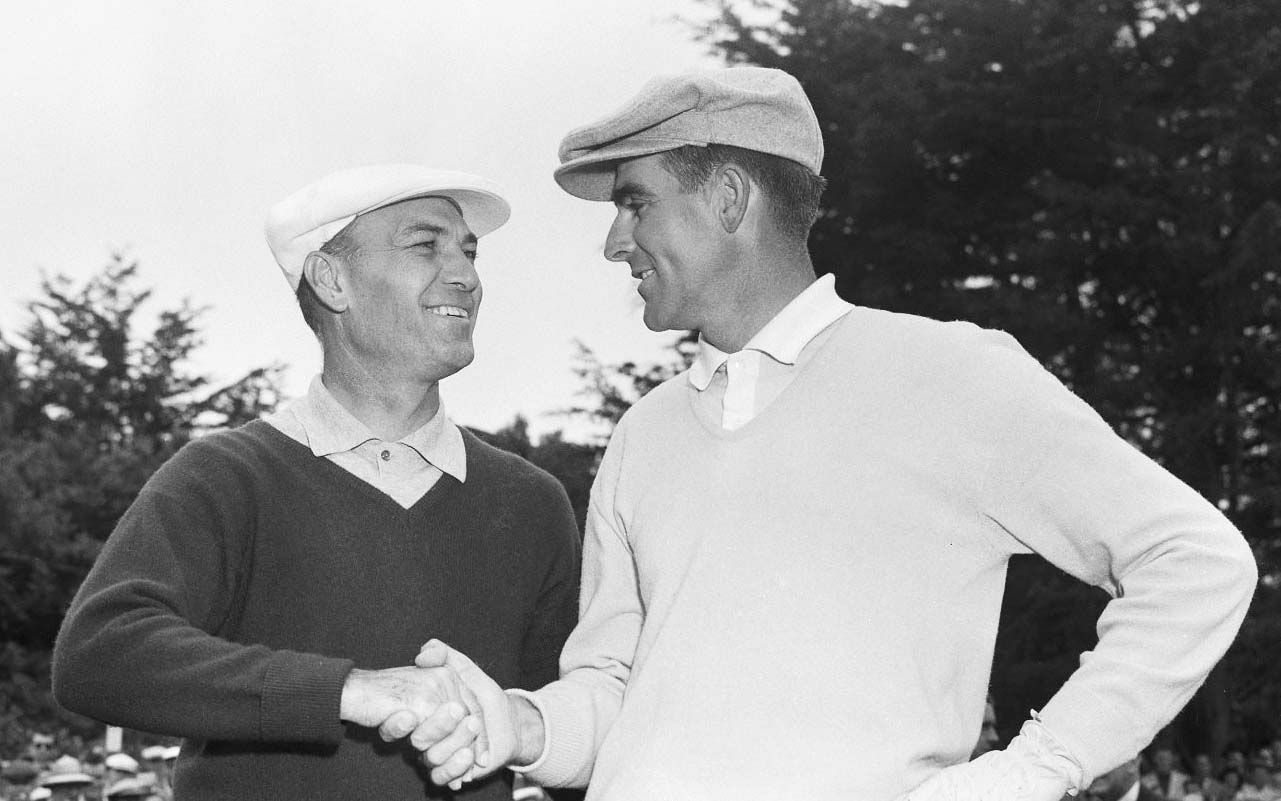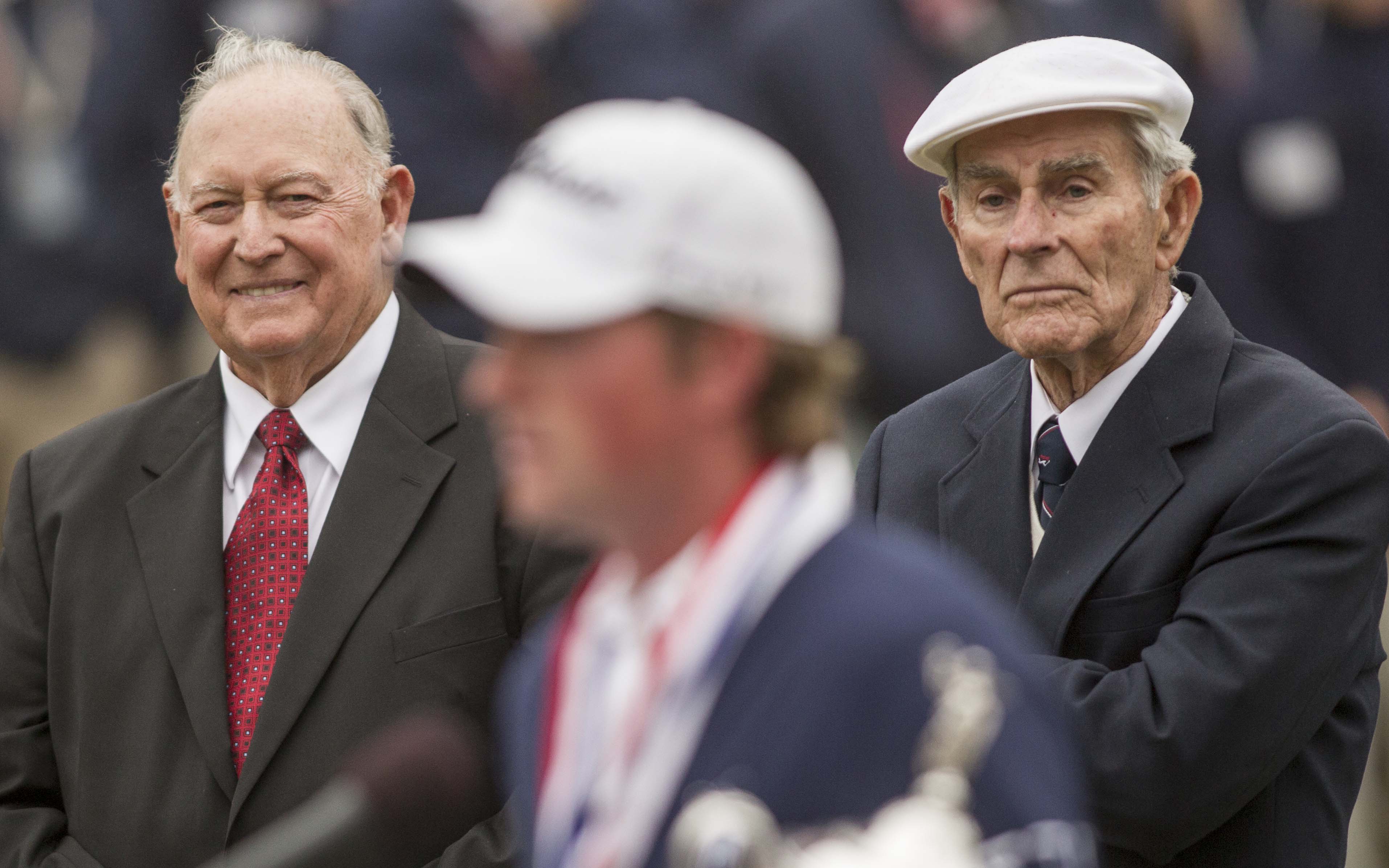When Jack slay the Giant
June 10-16, 2019
By Jay Edwards
In the southeast corner of the City by the Bay sits part of the old Olympic Athletic Club known as the Lake Course. It is 18 holes with majestic views of the Golden Gate Bridge and the Pacific Ocean, an unsentimental place where titans of the game seldom fare well.
Take Tom Watson, who was an eight-time major champion when he arrived at Olympic for the U.S. Open in 1987. Five years earlier the man from Kansas City had been at the top of the golfing world, with a U.S. Open victory that came 116 miles to the south at Pebble Beach. A month later he got his fourth British Open Championship at Royal Troon, which he defended successfully the next year at Birkdale.
So, in 1987, when Watson came to the 10th hole in the final round with a one-shot lead, he was confident. But so was Scott Simpson, who finished at minus three to Watson’s minus two. Watson would never win another major. Nineteen sixty-six was more dramatic, as the King himself, Arnold Palmer, was also looking for major resurgence, the most recent of his seven coming two years earlier at Augusta. No one doubted that Arnie would make it eight, as he stood on the tenth tee in the final round with a seven-shot lead over Billy Casper. But when they got to the 18th, Palmer had to make a difficult up and down from deep rough just to get into a playoff, which he did, only to blow up on the back nine again the next day and lose by four shots. Palmer would win 19 more times on tour, but never another major.
Those two upsets pale in comparison however, to what took place in 1955, when a journeyman from Iowa named Jack Fleck knocked off the great Ben Hogan. Jack Donald Fleck was born on Nov. 7, 1921, near Davenport, Iowa. One of five children, young Jack began working at an early age to help out his struggling family. “We were dirt poor,” he said, telling of having to pick fruit for pennies when he was in kindergarten.
Fleck became a golf pro when he was 17 and when America entered World War II he served in the Navy, returning to Davenport when the war ended, to his job as club pro at two municipal courses. He kept working on his game and playing in small tournaments at every chance until, wondering how he’d compare against touring professionals, he began entering PGA tournaments. Encouraged by the results, he joined the PGA Tour full time in 1955, with a personal goal of two years to prove he could cut it, against the best of the day.
Fleck arrived in San Francisco in 1955 to play in his third U.S. Open. In 1950 he had missed the cut and in 1953 he finished tied for 52nd. But in 1955 at Olympic, something seemed different about him, after he made it through sectional qualifying. “There was something about my nervous system that whole week,” he said. “I was so calm.”
But so was the man Fleck had once called his idol, and whose name was on the clubs in Fleck’s bag. Ben Hogan came to Olympic in 1955 chasing what no one has ever accomplished, a 5th U.S. Open victory.
Hunting the Hawk
Six years earlier, on a damp and foggy morning in early February of 1949, Ben Hogan was up before dawn, having coffee at the El Capitan Motel coffee shop in Van Horn, Texas, while his wife, Valerie, slept back in their room. They were traveling home to Ft. Worth and still had over 500 miles to go. At the top of the golfing world, Hogan was coming off victories the year before at the PGA and U.S. Open. In those days, touring golf pros, even the best, traveled mostly by automobile. After his breakfast, Hogan woke his wife, packed their luggage and his golf clubs in the trunk of their Cadillac and headed down Highway 80.
Ten miles later they were hit head on by a Greyhound bus that was attempting to pass a truck. A second before impact, Hogan threw himself across his wife to shield her, which actually saved his life, as the steering column was thrust through the driver’s seat. Valerie escaped with minor injuries, but Ben didn’t fare as well, having a broken collarbone, ankle, ribs, and a double fracture in his pelvis. The early prognosis was that his career was over.
Fifty-six days later he came home from the hospital and 14 months after that, in June of 1950, he won his second U.S. Open. He added two more, in 1951 and 1953, the same year he won the Master’s and the British Open, bringing his total number of majors to nine. After coming in second three times in majors in 1954 and 1955, Hogan, the man they called “The Hawk,” because of the way he studied a course, came to Olympic hungry for a win. He started well, shooting two over par 72 the first day, which tied him for fourth and five shots back of Tommy Bolt. Fleck carded a 76 and would need a lot of improvement in round two, which he got with a 69, tying him with Hogan and two others in third place, one shot behind Bolt and amateur Harvie Ward. The completion of round three found Hogan in a familiar spot atop the leaderboard, a shot better than Sam Snead and Julius Boros. Fleck, after a disappointing 75, fell back into a tie for sixth.
Hogan finished the fourth round with a 72, and it appeared as if he’d locked up a fifth title. In those days the third-round leader was not necessarily in the last group. Fleck was still on the course and the only one with a reasonable chance, after Snead bogeyed the 16th and the 17th. But the tall Iowan would have to play the difficult last four holes at two under to get into a playoff.
He birdied the par 3 15th, sinking a nine-foot putt, then parred the 600-yard 14th. He had 40-feet for birdie on 17, which he barely missed, setting up the must make birdie on the last. Hogan had been in the locker room for the past hour, mostly listening to people congratulate him on the victory. He knew Fleck needed a birdie to tie, and he hoped he’d either make four or two, his weary legs and battered body dreading the thought of another 7,000-yard walk. It seemed he had nothing to worry about when someone came in and reported that Fleck’s tee shot had found the rough. After another agonizing wait, no report was needed as the roar from the crowd said Fleck had gotten his three. Back in the locker room, Hogan put his head in his hands and cursed under his breath.
Monday’s playoff was a story of Fleck’s hot putter against Hogan’s iron will. The Hawk had plenty of chances to fold as his opponent rolled in yards and yards of putts. But of course, he didn’t. They came to 18 with Fleck one ahead. After Hogan hooked his drive into the thick rough he finally got back to the fairway after three more strokes. Fleck would make par, and Hogan, always the competitor, made his 25-foot downhill putt for double bogey.
They shook hands on the green and walked off together. Fleck had shocked the sporting world, but Hogan stunned them almost as much when he announced to the 10,000 patrons that he was retiring from tournament golf. “I came here with the idea of winning, but from now on I’m a weekend golfer,” he said. He was 42.
Fleck would win twice more on the PGA Tour, in 1960 at the Phoenix Open and in the 1961 Bakersfield Open. He won the PGA Seniors’ Championship in 1979. He moved to Arkansas in 1988 and built a golf course in the small town of Magazine in Logan County, that he named the Lil’ Bit a Heaven Golf Club. It opened in 1992 and flooded a year later, prompting Fleck to sell his U.S. Open medal to raise money for repairs. The course eventually closed for good in 2003 and Fleck moved to Ft. Smith with his wife, Carmen, whom he had married in 2001. He died on March 21, 2014 and is buried in Fort Smith National Cemetery. He was inducted into the Arkansas Sports Hall of Fame in 2015.
Sources: Encyclopedia of Arkansas, Youngstown Vindicator, New York Times, golf.com: The Longest Shot by Neil Sagebiel, 2012.
PHOTO CAPTIONS:
1. Jack Fleck (right) and Ben Hogan shake hands before beginning their playoff in the 1955 U.S. Open. (Source: Golf Digest)
2. Jack Fleck (right) and Billy Casper returned to the Olympic Club in 2012. Here they listen as Webb Simpson addresses the gallery after his win in that year’s championship. (Source: USGA)




